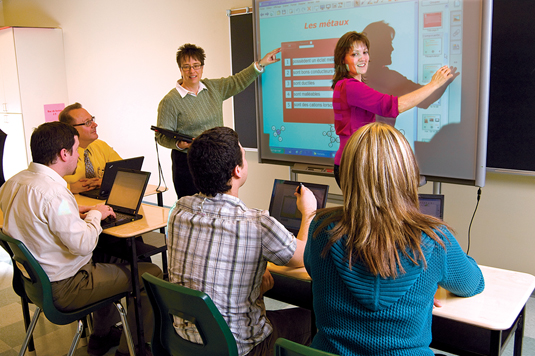|
Sporting Chanceby RIchard Young |
This program is giving my colleagues and me the time and resources to go far beyond just learning how to use new technology. We are doing lesson planning and thinking about ways to engage all types of learners. SMART boards and laptops enable teachers to connect with the visual, the kinesthetic and the auditory learners in our classrooms in ways we never have before.” Natalie Tessier is one of over 1,000 teachers taking part in the Ministry of Education’s Teacher Learning and Leadership Program (TLLP) this year. A resource teacher at École secondaire catholique Trillium in Chapleau, Tessier is using a Ministry grant to become certified to use SMART boards in the classroom and will then train and support colleagues in her school and throughout the Conseil scolaire de district catholique du Nouvel-Ontario. After that, she and her colleagues will develop and share curriculum designed to integrate the technology into the Grade 9 math and Grade 10 French programs, with a focus on improving EQAO test scores. The Ministry of Education is inviting teachers to submit proposals for next year’s TLLP. Like Tessier, successful applicants will receive funding to expand their knowledge and skills in areas where they already possess relevant background or experience and to share exemplary practices with other teachers within and beyond their schools and boards.
Camille Chénier, a senior policy advisor at the Ministry, explains that the program is a collaborative effort of the Ministry and the teachers’ federations to provide for time release, learning materials and other essentials to support these self-directed advanced professional development opportunities. College members are eligible if their primary assignment is teaching students and they are working in provincially funded district school boards, school authorities or provincial schools and are beyond the induction career stage. This includes classroom teachers, teacher-librarians, guidance counsellors, co-op teachers and itinerant or occasional teachers. Either individual teachers or groups of teachers may submit funding proposals. Groups must be teacher led but may include other education workers such as education assistants and professionals such as social workers, as well as parents and other community members. Chénier explains that proposals should present innovative professional learning topics related to effective practices for student learning and development. At the same time, they should focus on enhancing teachers’ learning experiences and practices. “Teachers are encouraged to think about what would help them be better professionals,” she elaborates. Projects or topics could include but are not limited to:
The program aims to take teachers beyond traditional PD activities. “We asked teachers what kind of professional development works best for them,” says Ontario Teachers’ Federation President Joe Lamoureux. “They told us they value time to learn together and the TLLP provides exactly that kind of opportunity.” The application process is structured. It begins at the school and moves to the school board and then the Ministry for joint Ministry and federation acceptance. Here’s how it works:
The next round of funding proposals will be due at the Ministry in late fall 2009. In the 2007-08 school year, there were two cohorts of successful applicants representing 155 projects involving research and work by approximately 1,000 people. Project selection criteria include but are not limited to the following:
Funds granted cover the cost of resources specific to the project (not capital expenses after project completion, such as classroom computers), teacher release time and travelling costs. Successful applicants must:
The Ministry leadership training focuses on project and budget management skills, SMART goals (Specific, Measurable, Attainable, Realistic, Timely) and adult learning styles for when it comes time to share research findings with colleagues. Teachers have a year to complete their projects and submit their reports. “We know that teachers learn best from other teachers,” says Education Minister Kathleen Wynne. “The TLLP has been designed to help our many excellent teachers further develop and share their particular expertise with colleagues throughout the province. “Teachers learn best from other teachers.” “As this network of professionals expands and shares its knowledge and skills with teachers in other classrooms, schools and boards, our students will benefit from their collaboration.” To learn more about the Teacher Learning and Leadership Program, including the application process, selection criteria and timelines, visit www.edu.gov.on.ca/eng/teacher/pdfs/guideline.pdf. If you have questions, contact the Ministry of Education at tllp-palpe@ontario.ca.
Current TLLP projectsIntegrating SMART-board technology into your teaching to improve student engagement and learningNatalie Tessier, a resource teacher at École secondaire catholique Trillium in Chapleau, will become certified and then train and support her colleagues in the use of SMART boards in the classroom. The goal is to truly integrate the technology into the curriculum, with a focus on improving student achievement in Grade 9 math and Grade 10 French EQAO testing. Tessier’s school has 15 teachers and 110 students in Grades 7 to 12 and she plans to work with all teachers and students during the school year. After her own colleagues, she will work with interested teachers at her board’s elementary school, École séparée Sacré-Cœur in Chapleau. Then it’s on to Wawa, Sault Ste. Marie and Blind River to train interested teachers and support them directly in the classroom as they use the technology. Via the board’s web site, Tessier will co-ordinate the sharing of all curriculum resources developed. For information contact Natalie Tessier at École secondaire catholique Trillium, 705-864-1211, in the Conseil scolaire de district catholique du Nouvel-Ontario. Classroom and school podcastingTeachers in several Ottawa-Carleton DSB schools are learning how to help students create and use podcasts as authentic applications for developing their writing, oral communication and media literacy skills. Nathan Toft and Jane Smith, teachers at A. Lorne Cassidy Elementary School in Stittsville, are leading this project. To find out more, visit Toft’s blog at www.communit.org/community/nathan/weblog/3841.html or contact Nathan Toft at nathan.toft@ocdsb.on.ca or Jane Smith at jane.smith@ocdsb.on.ca or at A. Lorne Cassidy Elementary School, 613-831-3434. Sharing oral language strategies – reaching out to Aboriginal/Métis families and organizationsTeachers in the Keewatin-Patricia DSB are working to reduce the gap in achievement levels between Aboriginal and non-Aboriginal students through community outreach to Métis and Aboriginal parents. Board data consistently shows a gap in the achievement levels of Aboriginal students compared to their non-Aboriginal peers. As well, Aboriginal students continue to struggle to meet provincial literacy standards. To address this situation, team members are working in their various communities to share best oral-language practices with the Aboriginal community and family members. Tanis Fisher, Carla Markowski, Candice Holmstrom, Annette Berry, Doris St. Jules and Laurie Pringle are oral-language special assignment teachers at elementary schools in Kenora, Red Lake, Ear Falls, Sioux Lookout and Dryden. The TLLP is making it possible for these professionals to come together even though they teach in schools hundreds of kilometres apart. Their goal is to improve the language skills of children before they enter kindergarten. The team has created oral-language resource kits and connected with community daycare centres to encourage parents to speak with and read to their pre-school-age children. The funding will also help pay for transportation and babysitting to bring in as many parents as possible to work with their children. At the same time teachers are learning more about Aboriginal culture, which they are taking back to their schools and classrooms and using with their students. “It’s a fantastic project,” says Fisher. “We are really excited about working on it this year and are confident that it will help the children who come to our kindergarten classrooms next fall.” For more information contact tanis.fisher@kpdsb.on.ca or call Lakewood Elementary School, Kenora at 807-468-3131.
Leading learning togetherLaurie-Ann Lielkalns, Ravi Vethamany, Erin Ferguson and Andrea Gammon are working on a project they call Leading Learning Together. They teach at Chelmsford Valley District Composite School in the Rainbow DSB. The group started by attending a 2008 summer institute on Barrie Bennett’s Beyond Monet: The Artful Science of Instructional Integration. Inspired by Bennett, group members are committed to changing the culture of their teaching. They are learning together to build their instructional intelligence and to teach more effectively by co-teaching, peer-mentoring, engaging in lesson study across divisions, grades and subjects, and working collaboratively to establish best practices and continuous improvement. “The TLLP is giving us the time we need to research, talk and reflect in meaningful ways that will truly help improve both our own practices and student learning and success,” says Lielkalns. For information contact lielkal@rainbowschools.ca or call Chelmsford Valley District Composite School at 705-675-0225. |











